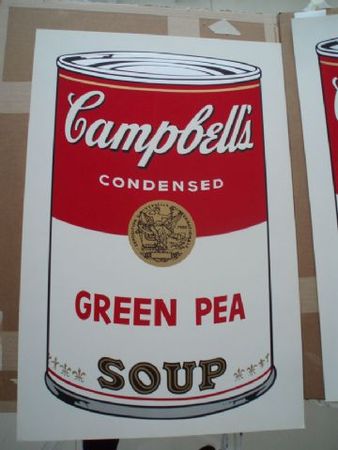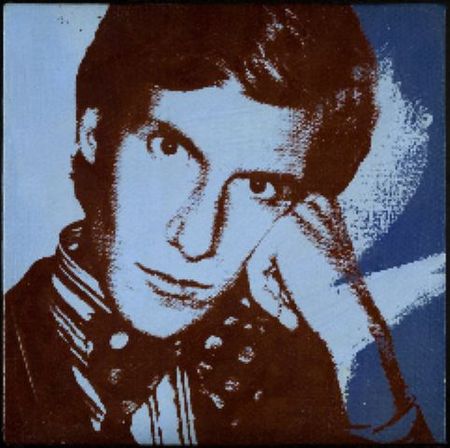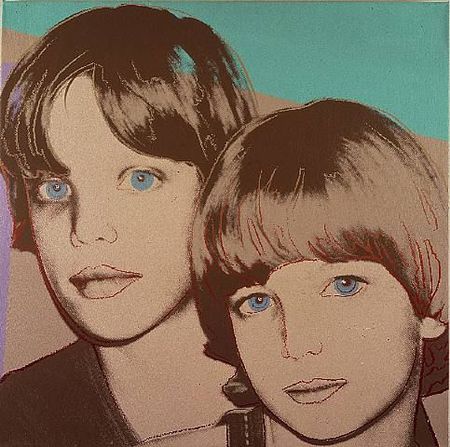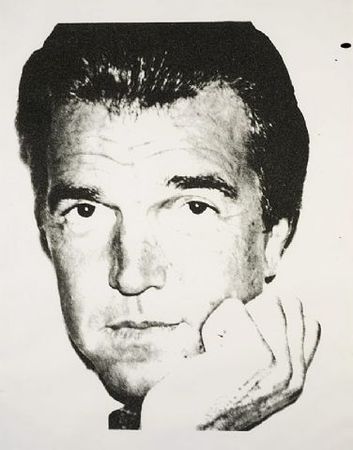Andy Warhol, "AUTOMAT" @ Galleri Trafo & Pollock Fine Art
Andy Warhol, Campbell's Green Pea, 1969
Trafo Gallery in association with Pollock Fine Art are pleased to announce an upcoming exhibition of paintings, drawings, photographs, screenprints, books and ephemera by Andy Warhol. Entitled Automat and emphasizing Warhol’s cool and impersonal style, the show differs from the present comprehensive survey at the Astrup Fearnly Museum, whose main premise is a personal take on the artist.
Andy Warhol, Eva Mudocci (After Munch), 1984
The title comes partly from Warhol’s love for the N.Y. Automat, a fast food restaurant where food and drink were served by coin-vending machines. Warhol even had his own unrealized vision for an automat, the Andymat. Seen as a meeting place for the lonely, the Andymats would have been—The Restaurant for the Lonely Person.
Andy Warhol, Marilyn Monroe (Marilyn) [II.29], 1967
Everything to do with Warhol is inclusive, the world’s largest private club. The instant one sees a Warhol artwork things improve- the viewer feels, happier, glamorous, sexy, very shiny , cool, good looking and possibly richer. Once owning a signed Warhol the membership get’s even better.
Andy Warhol, Marilyn Monroe (Retrospective Series), circa 1978
AUTOMAT explores the Andy state of mind-cold and mechanical, solitary but social, celebrating a creative force with no message that’s both obsessive and infinitely repetitive. Like Walt Disney, Warhol’s greater desire was to transform art into entertainment and vice versa. Also like Disney, the Warhol effect; it’s grand democracy-must be it’s basic universal appeal. Everywhere in the world Mickey Mouse and Marilyn Monroe are equally recognizable.
Andy Warhol, Portrait of Yves St. Laurent, 1972
Weather depicting a drag queen or Queen Elizabeth, the image is never entirely fixed. Warhol commented that Coca Cola tasted the same when drunk by Liz Taylor or anyone else. A photograph is mechanically reproduced by another device, than multiplied to numerous variations across surfaces of canvas or paper. Then it’s reproduced again and again, dead or alive ad infinitum. Posthumous questions of an original Warhol are left to the Andy Warhol Authentication Board.
Andy Warhol, Superman
A machine records, and Warhol may have been the greatest single recorder of the 20th century (he called his tape recorder his wife). Like that other great obsessive Balzac, Warhol’s body of work becomes interconnected. His work faces a mirror towards society whilst it stands alone for it’s power to both simultaneously record and affect the world. He never could have finished that job with paint and brushes!
Andy Warhol, The Beatles, 1980
Partially his desire to be a machine was a reaction to the Abstract Expressionism of the 1950’s a movement that by the early sixties seemed both formula and stale. Warhol’s response to its canned spontaneity was to employ devices such as the use of inkblot transfers, silkscreen printing, diamond dust, and oxidized urine as well as filling the Factory with assistants to do the work for him. Thankfully, there was a ghost in the machine who even looked different from other artists, with a white fright wig and a blank expression that was as dead as heroin chic. As cold as it was, Warhol’s production always allowed for the accidental (Duchamp’s chance operation). First by the ‘bad’ hand printing of himself and Gerard Malanga, then by printing his screens off register and repeating the image endlessly (but never consistently). Finally in the 80’s with Rupert Smith’s workshop making most of the design and color decisions, he stood back and allowed the art to take shape without his own hand or input. He intuitively understood, if he personally completed a work it would be smothered. To this day it continues in the work of others, as Warhol saw no limits. From Koons to Hirst to Murakami, we see the entire repertoire of Warhol’s game being played out.
Andy Warhol, Unidentified Child, 1984
The physics defy Steven Hawkins (that other genius in glasses) because the matter of Warhol’s production is constantly expanding (by denotation of issue, technique and medium, value, Google hits, publicity, exhibition, imitation etc. ad nauseam). Meanwhile its essence or content (or message) is so elusive that it must be shrinking into a vortex or at least a very dark hole. Automat needs a Metropolis and New York was where Andy chose to makes his Factory, with Hollywood glamour as its Shangri la. In N.Y. Warhol morphed into a new sort of human-an unlikely star -ubiquitous yet not completely present. He stood next to the famous and soon eclipsed their fame. From Warhol’s acceptance of the mechanization of existence it is not a great distance to our own world of genetic engineering, plastic surgery as well as sex change and other scientific and medical alternatives. Why should humans evolve when they can be re-touched?
Andy Warhol, Unidentified Children
Warhol spoke of a world without Warhol and described it as a figment. It could have been his last work, and a new definition of a 21st century man. “I always thought I'd like my own tombstone to be blank. No epitaph, and no name. Well, actually, I'd like it to say "figment”.
Nov 1 - Nov 30, 2008.
Galleri Trafo, Lensmannslia 60, 1386 Asker, (by Asker station) - ph: + 47 66 90 40 06 - www.galleritrafo.no
| Pollock Fine Art, 58a King Henry's Road, Primrose Hill. NW3 3RP London, United Kingdom - Tel: +44 (0)20 74490714 - www.pollockfineart.com | |
Andy Warhol, Untitled Portrait (Jean Pave Barbier), 1979

/https%3A%2F%2Fprofilepics.canalblog.com%2Fprofilepics%2F1%2F0%2F100183.jpg)
/https%3A%2F%2Fstorage.canalblog.com%2F03%2F02%2F119589%2F96711876_o.jpg)
/https%3A%2F%2Fstorage.canalblog.com%2F11%2F31%2F119589%2F94773502_o.jpg)
/https%3A%2F%2Fstorage.canalblog.com%2F20%2F83%2F119589%2F94772815_o.jpg)
/https%3A%2F%2Fstorage.canalblog.com%2F26%2F72%2F119589%2F75604929_o.jpg)
/https%3A%2F%2Fstorage.canalblog.com%2F59%2F60%2F119589%2F26458628_o.jpg)












/http%3A%2F%2Fstorage.canalblog.com%2F89%2F93%2F119589%2F127899898_o.jpg)
/http%3A%2F%2Fstorage.canalblog.com%2F81%2F83%2F119589%2F120714101_o.jpg)
/http%3A%2F%2Fstorage.canalblog.com%2F84%2F63%2F119589%2F120641874_o.jpg)
/http%3A%2F%2Fstorage.canalblog.com%2F98%2F01%2F119589%2F115928748_o.jpg)